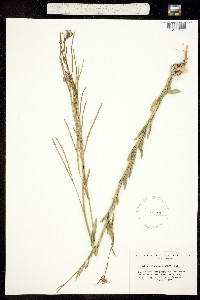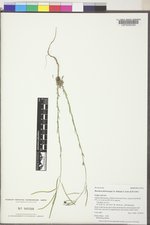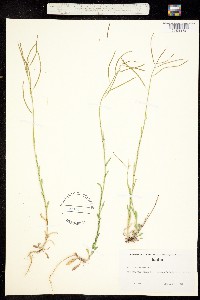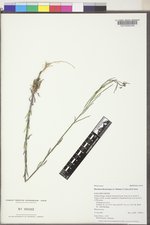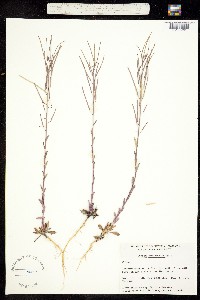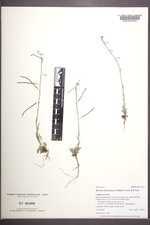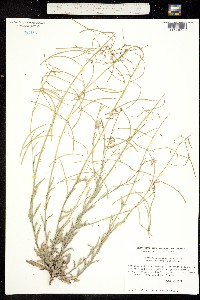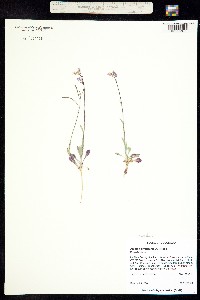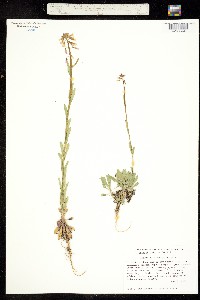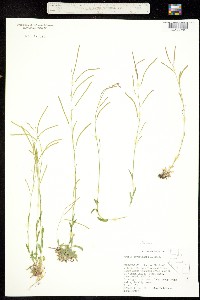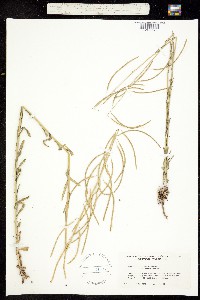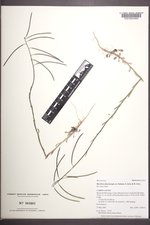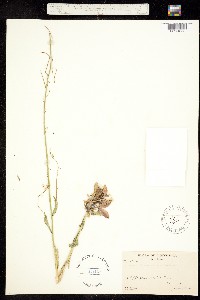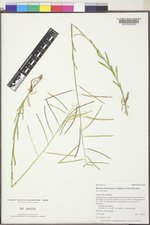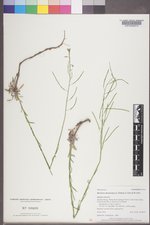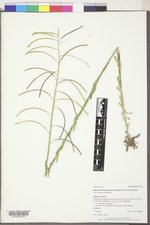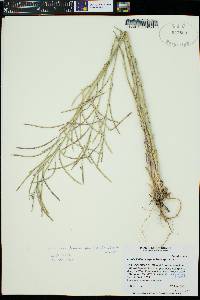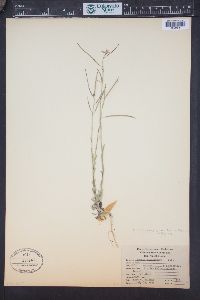Boechera divaricarpa
|
|
|
|
Family: Brassicaceae
spreadingpod rockcress
[Arabis brevisiliqua Rydb.] |
Biennials or perennials; short-lived; apomictic; caudex present or absent. Stems usually 1 per caudex branch, arising from center of rosette near ground surface, (1.5-)3-9 dm, glabrous or pubescent proximally, trichomes sessile, 2-4-rayed (some simple), to 0.7 mm, glabrous distally. Basal leaves: blade oblanceolate, 2-10 mm wide, margins usually entire, rarely denticulate, ciliate along petiole, trichomes (simple), to 0.8 mm, surfaces sparsely to densely pubescent, trichomes sessile, 2-6-rayed, 0.1-0.4 mm. Cauline leaves: (10-)15-56, concealing stem proximally; blade auricles 1-5 mm, surfaces of distalmost leaves glabrous. Racemes 12-40(-65)-flowered, usually unbranched. Fruiting pedicels divaricate-ascending to horizontal, straight, 5-12 mm, glabrous. Flowers divaricate-ascending at anthesis; sepals glabrous or with scattered trichomes; petals usually purple, rarely lavender, 6-9 × 1.5-3 mm, glabrous; pollen spheroid. Fruits divaricate-ascending to horizontal, not appressed to rachis, not secund, straight, edges parallel, (4.5-)5.5-11 cm × 1.7-2.5 mm; valves glabrous; ovules 114-142 per ovary; style 0.05-0.2 mm. Seeds uniseriate to sub-biseriate, 1.4-2 × 1-1.5 mm; wing continuous, 0.1-0.2 mm wide. 2n = 21. Flowering May-Jul. Rock outcrops, talus slopes and gravelly hillsides in sagebrush, mountain shrub, and open conifer forests; 900-2500 m; Calif., Idaho, Mont., Nev., Utah, Wash., Wyo. The name Arabis (Boechera) divaricarpa has been applied to nearly every hybrid containing a genome derived from B. stricta. This presents a serious barrier to understanding the evolution of Boechera and also is contrary to the International Code of Botanical Nomenclature, because some names usually placed in synonymy (i.e., B. grahamii and B. brachycarpa) have priority at species level (M. D. Windham and I. A. Al-Shehbaz 2007b). To address this problem, we treat the following as distinct species: B. acutina, B. grahamii (= B. brachycarpa of R. D. Dorn 2001), and B. pratincola (all considered synonyms of A. divaricarpa by R. C. Rollins 1993), and B. calderi, B. elkoensis, and B. quebecensis (taxa described after 1993). Detailed comparison among these taxa are provided by Windham and Al-Shehbaz (2007, 2007b). The narrow concept of B. divaricarpa advocated here encompasses apomictic triploid populations containing three distinct genomes, one each derived from B. retrofracta, B. sparsiflora, and B. stricta. If the species is defined more broadly, the name B. grahamii has priority.
Biennial herb to 1 m tall Stem: upright, hairy at base. Flowers: in branched, spreading clusters, pinkish or white, 5 - 8 mm long. Petals four. Stamens six. Fruit: a narrow pod, spreading, 3 - 9 cm long, 1.2 - 2.2 mm wide, on a 6 - 12 mm long stalk, straight or nearly so. Seeds in one or two rows. Basal leaves: reverse lance-shaped with the attachment at the narrower end, star-shaped hairs on both sides. Stem leaves: alternate, upright or nearly so, 2 - 5 cm long, lance-linear to oblong. Similar species: The similar Boechera shortii differs by having stems that are hairy up to the summit. Flowering: June to July Habitat and ecology: In the Chicago Region, Boechera divaricarpa is known only from Walworth County, Wisconsin and Starke County, Indiana. It was found growing in dry sand and open sun. Typical of sandy and rocky soil. Occurence in the Chicago region: native Etymology: Boechera refers to the Danish botanist, Tyge Bocher. Divaricarpa means spreading-fruited. Author: The Morton Arboretum |

